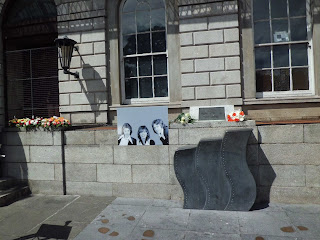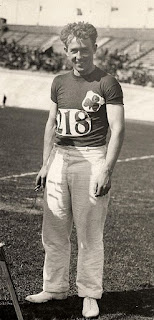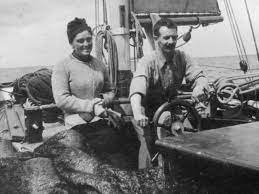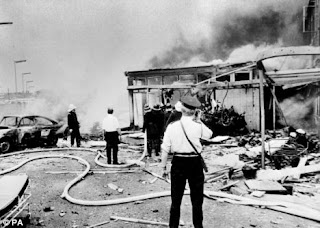21 July 1972: Bloody Friday. In a devastating series of
attacks the Provisional IRA planted 22 bombs across the city of Belfast killing
9 people and injuring over 130 - most of them innocent civilians. Among the
injured were 77 women and girls, and 53 men and boys.
The IRA said it had sent adequate warnings for all of the
bombs and accused the British forces of wilfully ignoring some of them for
propaganda purposes. Others, however, say that they had been overwhelmed by the
amount of bombs and bomb warnings and could not respond in time to clear all
areas of civilians.
The first one went off around 2.10pm on that sunny afternoon
at Smithfield Bus Station and the last was recorded at 3.30pm on the Grosvenor
Road.
The one at the Oxford Street Bus Depot at 2.48pm caused six
fatalities. Two British Army soldiers, Stephen Cooper (19) and Philip Price
(27), were close to the car bomb at the moment of detonation and died
instantly. Three Protestant civilians who worked for Ulsterbus were killed:
William Crothers (15), Thomas Killops (39) and Jackie Gibson (45). One other
Protestant Ulsterbus employee, who was a member of the Ulster Defence
Association, was also killed in the blast: William Irvine (18). Close to 40
people were injured.
At 3.15pm a car bomb, estimated at 50 pounds of explosive,
exploded without warning outside a row of single storey shops near the top of
Cavehill Road, north Belfast. The shops were in a religiously-mixed residential
area. Two women and a man died in this blast. Margaret O'Hare (37), a Catholic
mother of seven children, died in her car. Her 11-year-old daughter was with
her in her car and was badly injured. Catholic Brigid Murray (65) and
Protestant teenager Stephen Parker (14) were also killed.
The attacks were a disaster for the IRA as there was
widespread revulsion throughout Britain and Ireland at these attacks on what
were seen as civilian targets. The aftermath of this was to lay the groundwork
for 'Operation Motorman' in which the British Army was able to occupy Free
Derry and eliminate the last of the 'No-Go’ areas at the end of the month.
Years later an RUC man at the time recalled:
The first thing that caught my eye was a torso of a human
being lying in the middle of the street. It was recognisable as a torso because
the clothes had been blown off and you could actually see parts of the human
anatomy. One of the victims was a soldier I knew personally. He'd had his arms
and legs blown off and some of his body had been blown through the railings.
One of the most horrendous memories for me was seeing a head stuck to the wall.
A couple of days later, we found vertebrae and a rib cage on the roof of a
nearby building. The reason we found it was because the seagulls were diving
onto it. I've tried to put it at the back of my mind for twenty-five years.
Brendan Hughes, Officer Commanding of the IRA's Belfast
Brigade, viewed the attack as a disaster.
I was the operational commander of the "Bloody
Friday" operation. I remember when the bombs started to go off, I was in
Leeson Street, and I thought, "There's too much here". I sort of knew
that there were going to be casualties, either [because] the Brits could not
handle so many bombs or they would allow some to go off because it suited them
to have casualties. I feel a bit guilty about it because, as I say, there was
no intention to kill anyone that day. I have a fair deal of regret that
"Bloody Friday" took place ... a great deal of regret ... If I could
do it over again I wouldn't do it
https://en.wikipedia.org/wiki/Bloody_Friday_(1972)#cite_note-38
Those who died:
Stephen Cooper (19), member of the British Army
William Crothers (15), civilian
John Gibson (45), civilian
William Irvine (18), civilian
Thomas Killops (39), civilian
Brigid Murray (65), civilian
Margaret O'Hare (34), civilian
Stephen Parker (14), civilian
Philip Price (27), member of the British Army












